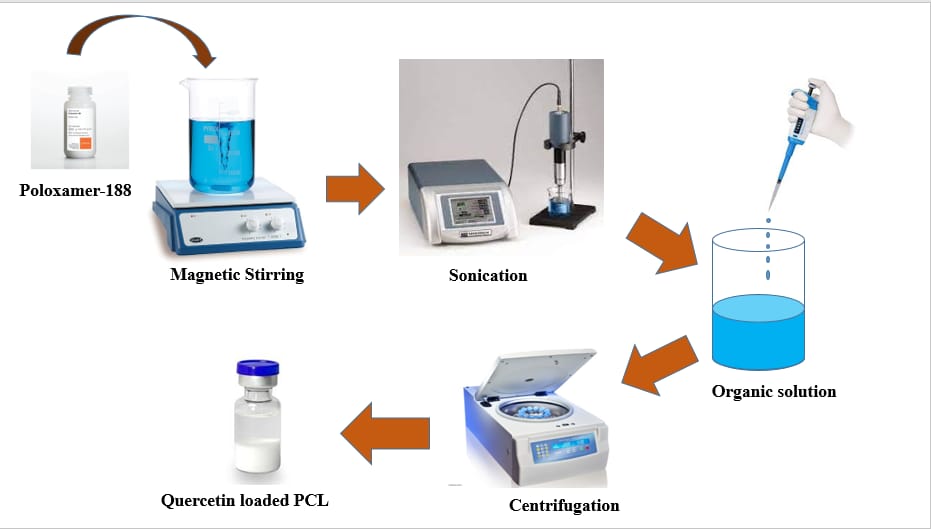Formulation development and characterization of quercetin loaded poly caprolactone nanoparticles for tumors
DOI:
https://doi.org/10.14295/bjs.v3i2.494Keywords:
nanoparticles, scanning electron microscopy, caprolactone, drug polymer, synthesis, quercetinAbstract
Cancer is a formidable health obstacle, characterized by its bleak outlook. Considerable scientific investigation has shed light on the capacity to modify the dispersion of anticancer medications at various levels within tissues and cells by enclosing them within submicronic colloidal systems, often known as nanoparticles. This approach is based on the goal of enhancing the therapeutic effectiveness of these medications while minimizing adverse effects on the entire body. Moreover, the theragnostic characteristics of these nanoparticles are widely acknowledged, hence enhancing their therapeutic potential. The current study is centered on exploring the potential anti-tumor effects of quercetin by utilizing its antioxidant capabilities. The quercetin nanoparticles are synthesized with great precision utilizing the nanoprecipitation approach, in which poly(caprolactone) is utilized as the polymer matrix. Following synthesis, the nanoparticles are extracted for further analysis. Further attempts are undertaken to enhance the drug loading process, and the resultant nanoparticles undergo a thorough analysis, including the examination of their morphology using scanning electron microscopy, and the evaluation of drug-polymer interactions using Fourier transform infrared spectroscopy and differential scanning calorimetry. The remarkable efficacy of quercetin's envelopment can be attributed to its lipophilic nature, reaching a maximum of 81%. The utilization of scanning electron microscopy allows for the observation of nanoparticles with varying forms. Conversely, the absence of noticeable interactions in Fourier-transform infrared analysis indicates the stability of poly(caprolactone) nanoparticles loaded with quercetin.
References
Cabral, R. M., & Baptista, P. V. (2014). Anti-cancer precision theranostics: a focus on multifunctional gold nanoparticles. Expert Review of Molecular Diagnostics, 14(8), 1041-1052. https://doi.org/10.1586/14737159.2014.965683 DOI: https://doi.org/10.1586/14737159.2014.965683
Chen, S-F., Nien, S., Wu, C-H., Liu, C-L., Chang, Y-C., Lin, Y-S. (2013). Reappraisal of the anticancer efficacy of quercetin in oral cancer cells. Journal of the Chinese Medical Association, 76(3), 146-152. https://doi.org/10.1016/j.jcma.2012.11.008 DOI: https://doi.org/10.1016/j.jcma.2012.11.008
Ezzati, M., Yousefi, B., Velaei, K., & Safa, A. (2020). A review on anti-cancer properties of Quercetin in breast cancer. Life Sciences, 248, 117463. https://doi.org/10.1016/j.lfs.2020.117463 DOI: https://doi.org/10.1016/j.lfs.2020.117463
Gibellini, L., Pinti, M., Nasi, M., Montagna, J. P., De Biasi, S., Roat, E., Bertoncelli, L., Cooper, E. L., & Cossarizza, A. (2011). Quercetin and cancer chemoprevention. Evidence-Based Complementary and Alternative Medicine, 2011, 591356. https://doi.org/10.1093/ecam/neq053 DOI: https://doi.org/10.1093/ecam/neq053
Guan, X., Gao, M., Xu, H., Zhang, C., Liu, H., Lv, L., Deng, S., Gao, D., & Tian, Y. Quercetin-loaded poly (lactic-co-glycolic acid)-D-α-tocopheryl polyethylene glycol 1000 succinate nanoparticles for the targeted treatment of liver cancer. Drug Delivery, 23(9), 3307-3318. https://doi.org/10.1080/10717544.2016.1176087 DOI: https://doi.org/10.1080/10717544.2016.1176087
Jiang, Q., Liu, Y., Guo, R., Yao, X., Sung, S., Pang, Z., Yang, W. (2019). Erythrocyte-cancer hybrid membrane-camouflaged melanin nanoparticles for enhancing photothermal therapy efficacy in tumor. Biomaterials, 192, 292-308. https://doi.org/10.1016/j.biomaterials.2018.11.021 DOI: https://doi.org/10.1016/j.biomaterials.2018.11.021
Kashif, M., Muhammad, S., Ali, A., Ali, K., Khan, S., Zahoor, S., & Hamza, M. (2023). Bismuth oxide nanoparticle fabrication and characterization for photocatalytic bromophenol blue degradation. Journal of Xi’ab Shiyou University, 19(07), 521-544. http://xisdxjxsu.asia/
Rather, R. A., & Bhagat, M. (2020). Quercetin as an innovative therapeutic tool for cancer chemoprevention: Molecular mechanisms and implications in human health. Cancer Medicine, 9(24), 9181-9192. https://doi.org/10.1002/cam4.1411 DOI: https://doi.org/10.1002/cam4.1411
Stratton, M. R., Campbell, P. J., & Futreal, P. A. (2009). The cancer genome. Nature, 458, 719-724. https://doi.org/10.1038/nature07943 DOI: https://doi.org/10.1038/nature07943
Sumer, B., & Gao, J. (2008). Theranostic nanomedicine for cancer. Nanomedicine, 3(2), 137-140. https://doi.org/10.2217/17435889.3.2.137 DOI: https://doi.org/10.2217/17435889.3.2.137
Zaman, S., Kashif, M., Shah, M., Hameed, A., Majeed, N., Ismail, M., Khan, I., Ullah, S., & Khan, N. (2024). Investigating the enhanced photocatalytic degradation of bromophenol blue using Ni/Zn co-doped Strontium oxide nanoparticles synthesized via hydrothermal method. Brazilian Journal of Science, 3(1), 102-114. https://doi.org/10.14295/bjs.v3i1.460 DOI: https://doi.org/10.14295/bjs.v3i1.460
Zhang, Y., Chen, Q., Zhu, Y., Pei, M., Wang, K., Qu, X., Zhang, Y., Gao, J., & Qin, H. (2020). Targeting inorganic nanoparticles to tumors using biological membrane-coated technology. MedComm, 3(4), e192. https://doi.org/10.1002/mco2.192 DOI: https://doi.org/10.1002/mco2.192

Downloads
Published
How to Cite
Issue
Section
License
Copyright (c) 2024 Muhammad Kashif, Murad Ali, Bushra, Saira Naz, Jalal Amir, Shafaq Murad, Muhammad Atif, Osama Ali Khattak, Saif Ullah, Seeqal Aleena, Naqash Khan, Muhammad Younis Khan

This work is licensed under a Creative Commons Attribution 4.0 International License.
Authors who publish with this journal agree to the following terms:
1) Authors retain copyright and grant the journal right of first publication with the work simultaneously licensed under a Creative Commons Attribution License that allows others to share the work with an acknowledgement of the work's authorship and initial publication in this journal.
2) Authors are able to enter into separate, additional contractual arrangements for the non-exclusive distribution of the journal's published version of the work (e.g., post it to an institutional repository or publish it in a book), with an acknowledgement of its initial publication in this journal.
3) Authors are permitted and encouraged to post their work online (e.g., in institutional repositories or on their website) prior to and during the submission process, as it can lead to productive exchanges, as well as earlier and greater citation of published work.



